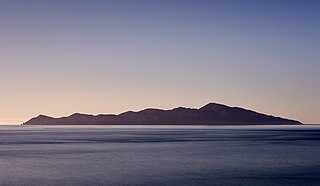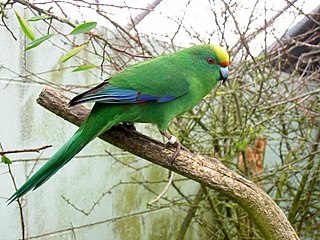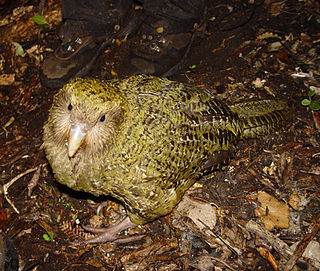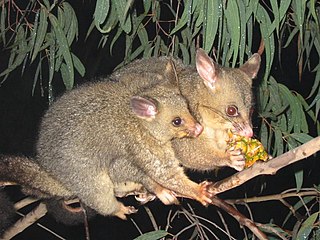
The stoat, also known as the Eurasian ermine or ermine, is a species of mustelid native to Eurasia and the northern regions of North America. Because of its wide circumpolar distribution, it is listed as Least Concern on the IUCN Red List. The name ermine is used especially in its pure white winter coat of the stoat or its fur. Ermine fur was used in the 15th century by Catholic monarchs, who sometimes used it as the mozzetta cape. It has long been used on the ceremonial robes of members of the United Kingdom House of Lords. It was also used in capes on images such as the Infant Jesus of Prague.

The kākāpō, sometimes known as the owl parrot or owl-faced parrot, is a species of large, nocturnal, ground-dwelling parrot of the superfamily Strigopoidea. It is endemic to New Zealand.

Fiordland National Park is a national park in the south-west corner of South Island of New Zealand. It is the largest of the 13 national parks in New Zealand, with an area covering 12,607 km2 (4,868 sq mi), and a major part of the Te Wāhipounamu a UNESCO World Heritage Site established in 1990. The park is administered by the Department of Conservation. The southern ranges of the Southern Alps cover most of Fiordland National Park, combined with the deep glacier-carved valleys.

Kapiti Island, sometimes written as Kāpiti Island, is an island nature reserve located 5.6 km (3 mi) off the west coast of the lower North Island of New Zealand and within the Kāpiti Coast District. Parts of the island were previously farmed, but it is now a predator-free sanctuary for endemic birds, including many endangered birds. The island is 10 km (6.2 mi) long, running southwest/northeast, and roughly 2 km (1.2 mi) wide, being more or less rectangular in shape, and has an area of 19.65 km2 (7.59 sq mi).

The South Island takahē is a flightless swamphen indigenous to New Zealand and the largest living member of the rail family. It is often known by the abbreviated name takahē, which it shares with the recently extinct North Island takahē. The two takahē species are also known as notornis.

Resolution Island or Tau Moana (Māori) is the largest island in the Fiordland region of southwest New Zealand, covering a total of 208 km2 (80 sq mi). It is the country's seventh largest island, and the second largest uninhabited island. Resolution Island is separated from the mainland of the South Island by Tamatea / Dusky Sound, Te Puaitaha / Breaksea Sound, and Acheron Passage. The island is part of the Fiordland National Park.

Malherbe's parakeet is a small parrot endemic to New Zealand, where it is known as the orange-fronted parakeet or orange-fronted kākāriki. In the rest of the world it is called Malherbe's parakeet, as when it was recognised as a species, the name "orange-fronted parakeet" was already used for Eupsittula canicularis, a Central American species. Restricted to a few valleys in the South Island and four offshore islands, its population declined to around 200 in the 1990s, and it is considered critically endangered by the IUCN.

The yellowhead or mohua is a small insectivorous passerine bird endemic to the South Island of New Zealand. Once a common forest bird, its numbers declined drastically after the introduction of rats and stoats, and it is now near threatened.

Secretary Island is an island in southwestern New Zealand, lying entirely within Fiordland National Park. Roughly triangular in shape, it lies between Doubtful Sound / Patea in the south and Te Awa-o-Tū / Thompson Sound in the north, with its west coast facing the Tasman Sea. To the east of the island, Pendulo Reach connects Te Awa-o-Tū / Thompson Sound with Doubtful Sound / Patea. Steeply sloped, the entirely bush-clad island rises to a chain of several peaks higher than 1000 metres. The highest of these is the 1,196-metre (3,924 ft) Mount Grono, the highest peak in the main New Zealand chain not located in the North or South Island. The island also contains three lakes. The largest, Secretary Lake, over 600 metres (2,000 ft) long, is located beneath Mount Grono at an altitude of 550 metres (1,800 ft).
Chalky Island or Te Kākahu-o-Tamatea is an island in the southwest of New Zealand, and is part of Fiordland National Park. It lies at the entrance to Taiari / Chalky Inlet, next to Rakituma / Preservation Inlet, at the southwestern tip of the South Island, 10 kilometres (6 mi) northwest of Puysegur Point, 15 kilometres (9 mi) southeast of West Cape, and 140 kilometres (87 mi) west of Invercargill. Chalky Island is one of the predator-free islands that is part of the Fiordland Islands restoration programme. The programme's focus is to eradicate pests and translocate native species.

Anchor Island is an island in Dusky Sound in Fiordland.
Richard Treacy Henry was a New Zealand conservationist and reserve manager who became an expert on the natural history of flightless birds in New Zealand, especially the kākāpō. Born in County Kildare, Ireland, his family migrated to Australia in 1851 where he grew up. He moved to New Zealand in the 1870s, settling in the south-west at Lake Te Anau in 1883 where he worked as a handyman, rabbiter, shepherd, taxidermist, boat-builder, explorer and guide, while studying the birdlife. He also began to write articles on natural history for the Otago Witness and other publications.

Pūkaha National Wildlife Centre is a captive breeding facility and visitor centre located in a protected forest area on State Highway 2 in New Zealand's Tararua district. It was formerly called Mount Bruce National Wildlife Centre, then Pūkaha / Mount Bruce National Wildlife Centre.

The birds of New Zealand evolved into an avifauna that included many endemic species found in no other country. As an island archipelago, New Zealand accumulated bird diversity, and when Captain James Cook arrived in the 1770s he noted that the bird song was deafening.

1080, the brand name given to the synthetic form of sodium fluoroacetate, is used in New Zealand in efforts to control populations of possums, rats, stoat and rabbits, which are invasive species in the New Zealand environment. Although the Parliamentary Commissioner for the Environment deemed the use of 1080 in New Zealand "effective and safe" in a 2011 re-evaluation and the substance is widely considered to be the most effective tool currently available for controlling possums over large areas, it remains a contentious issue, with the majority of the debate occurring between conservationists and livestock farmers on one side and hunters and animal-rights activists on the other.

Victoria Forest Park, is situated on the West Coast of the South Island of New Zealand. At 2,069 square kilometres (799 sq mi) it is New Zealand's largest forest park. The park is administered by the Department of Conservation (DOC).

Great Island is an island in the southwest of New Zealand, and is part of Fiordland National Park. It lies in Taiari / Chalky Inlet, north of Chalky Island and contains two small lakes, Lake Dobson and Lake Esau.

The Murchison Mountains are a group of mountains in Fiordland National Park in New Zealand. It is the location where the South Island takahē, a type of bird presumed extinct, was rediscovered in 1948. The highest mountain is Mount Lyall at 1,892 metres (6,207 ft).
The Fiordland Islands restoration programme is run by the New Zealand Department of Conservation. The purpose of the programme is to eradicate pests on key islands around Fiordland National Park, once the islands are considered predator free endangered native species will be translocated to the islands.

Sanctuary Mountain Maungatautari, is a protected natural area in Waikato Region, New Zealand where the biodiversity of 3,400 ha of forest is being restored. The sanctuary covers the mountain peak, Maungatautari.





















